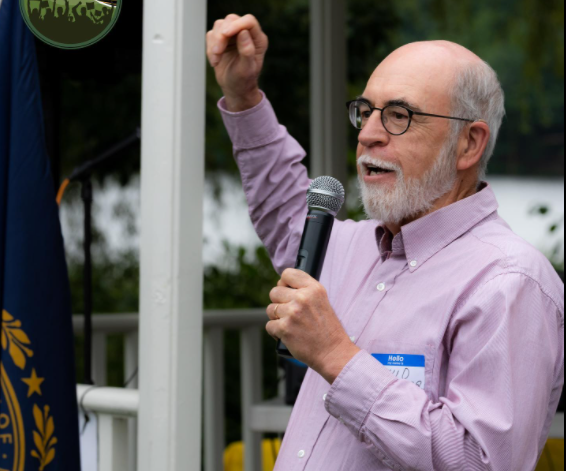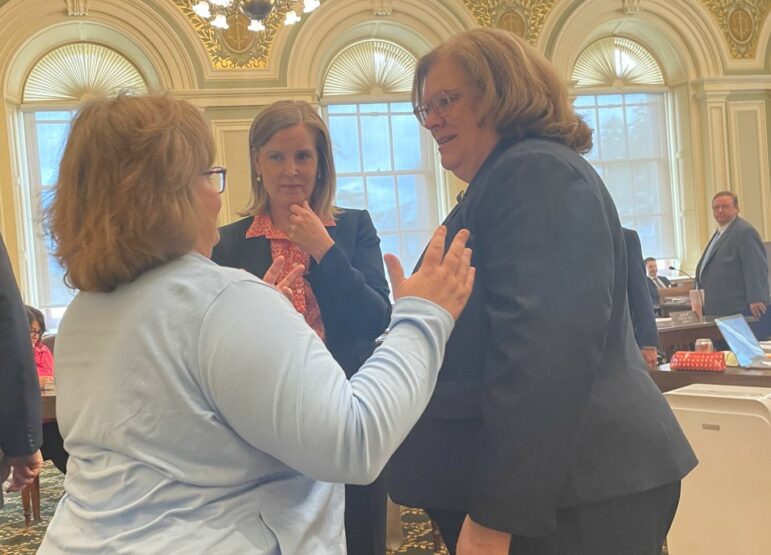By Thomas P. Caldwell, InDepthNH.org
PORTSMOUTH — Mark Sanborn, in his new role with the state Department of Energy, asked those attending a hearing at the Pease International Tradeport for their concerns about a proposed offshore wind project in the Gulf of Maine.
“This isn’t a place to talk about how great offshore wind is,” Sanborn told the attendees during the July 26 meeting of the Commission To Study Offshore Wind. “We want to draw out the things that folks are most concerned about because actually moving forward with an official process will allow all voices to be heard. I think even those who are the strongest supporters of offshore wind realize nothing is 100 percent positive, and nothing is 100 percent negative.”
Erik Anderson, president of the New Hampshire Commercial Fishermen’s Association, raised the questions his industry has about the impacts on marine life and the fishing economy.
“It’s almost a build it and see what happens strategy,” he said of the movement to bring wind energy into the New England electric grid. “I think this assessment study should have some type of investigation. There’s a tremendous amount of information about this offshore wind endeavor, but there is a tremendous amount that is not known.”
As an example, he said very little is known about electromagnetic fields that develop around the transmission lines between the floating wind towers and the on-shore transmission system. “We have very little information about how it’s going to impact certain species in New Hampshire. For example, just pick lobsters: Will that species not cross that line?” he asked.
Information emerging from the Block Island wind project in Rhode Island indicates that the offshore array is damaging the scallop population.
Anderson also questioned the impact of sound, both during construction and during operation. “What’s the effect on the environment from a sound perspective?” he asked.
Questions arose about the ability of the current electrical transmission system to handle more power without significant upgrades and whether electric demand can be met without wind when the Seabrook Nuclear Power Plant reaches the end of its lifespan. Initiatives to switch from gasoline- to electric-powered automobiles will require more charging stations.
The Gulf of Maine is considered one of the best-suited locations for offshore wind in the United States and perhaps the world. The Maine Governor’s Energy Office is focusing on a 16-square-mile area about 25 miles south of Muscongus Bay for the siting of up to 12 floating wind-power turbines, each producing between 10 and 14 megawatts of power.
Supporters at the hearing noted that Europe is ahead of the United States in its use of wind power, and they said New Hampshire should look across the sea for answers to the questions raised.
Others said the study should make sure any proposal addresses environmental justice — fairly treating everyone who might be affected by the development of offshore wind power.
Much of the hearing concerned the process going forward. Sanborn said the purpose of the hearing was to help guide the state in developing a request for proposals to attract the best consultants. The contractor will then conduct an assessment of the pros and cons associated with offshore wind. The assessment will not include a recommendation but will provide background information for the state’s policymakers to use as a guide.
Sanborn said he wants members of the public to weigh in on the potential contractors to help make sure the state hires the right individuals to conduct a fair review of the facts. “They’re going to be using existing resources, but part of what we’ll ask them to do is talk to stakeholders to get input from everyone, with the goal of probably a six-month period for them to conduct the assessment.”
He expects the final draft to be released about this time next year.
State Sen. David Watters, serving as chair of the meeting, joined Sanborn in providing the background for Monday’s meeting. When Gov. Chris Sununu signed House Bill 2 into law, it created a new Department of Energy that brought together the Office of Strategic Initiatives and the program and policy functions of the Public Utilities Commission, leaving the PUC with only its regulatory role. The Office of Strategic Initiatives formerly had several responsibilities and jurisdictions, one of which was energy policy.
The PUC, the Site Evaluation Committee, the Office of Consumer Advocate, and the Energy Efficiency and Sustainable Energy Board are administratively attached to the Department of Energy. The Commission To Study Offshore Wind also falls under the new DOE.
Sununu has named Jared Chicoine, the former OSI director, as the interim commissioner of the new Department of Energy. An announcement of the commissioner is expected to come soon.
Sununu also has asked for two reports to be delivered by October: looking into greenhouse gases and how that could influence offshore wind and economic development opportunities.
“But it also became obvious to me that we needed two things: a public forum where the public had a chance to really voice what they want looked at when it comes to offshore wind and its impact in New Hampshire and the region; and having that information in one location,” Sanborn said.
Watters said developing the report will help when it comes time to discuss the project with neighboring states and the federal government. He hopes the assessment will include a close look at the “consistency process” — the means by which a state can assert its interests in coastal uses or resources.
The committee is taking testimony through Friday at osi.osiinfo@osi.nh.gov.





